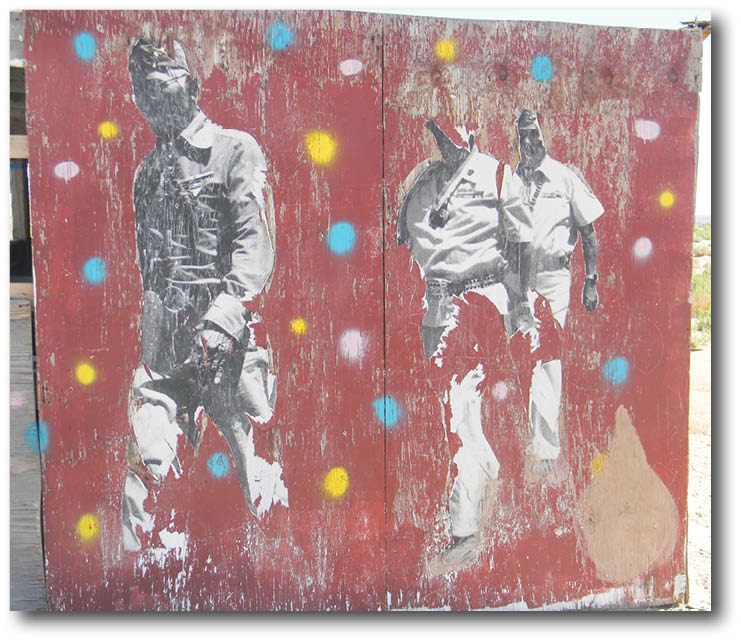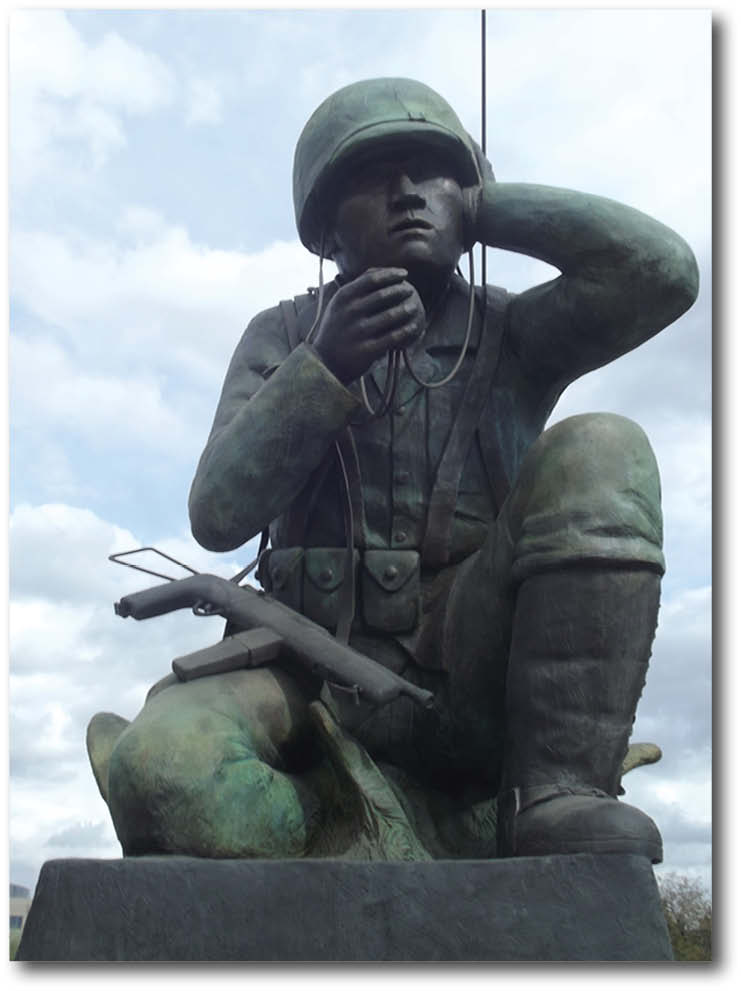In the heart of downtown Phoenix, on the corner of Central Avenue, there is a statue dedicated to the Navajo Code talkers of World War II. Reclining and relaxed, dressed in casual comfortable clothes, with a head band stretched across his forehead, this is not your ordinary statue dedicated to warriors but then the Navajo Code talkers were not your average warriors.
After the Japanese surprise attack on Pearl Harbor, American military commanders quickly realized the need for top secret communications of their own, especially during a campaign being fought all across the biggest ocean in the world. It was a civilian, Phillip Johnston who came up with the idea of specially trained Navajo soldiers speaking on the radio in their native tongue. Johnston’s parents had been missionaries to the reservation when Johnston was a young boy. At the age of nine he was fluent in the Navajo language and even served as the translator for a reservation delegation visiting president Theodore Roosevelt and Washington DC. When World War II broke out, Johnston knew that there were not more than 30 or 40 adult non Navajo on the planet who could speak the language. In the 1940s a Navajo dictionary had never been compiled, it would be the perfect language for a secret code.
During World War I the American military had experimented with using eight Choctaw to translate and send messages. Also during World War I, the Canadian army had tried to send secret messages using Native Americans speaking their native tongues. The Canadians had discovered that many Native American languages were not well adapted to using modern military terminology. Philip Johnston believed that the Navajo; language was especially adaptable and had the capacity to easily create new words to describe modern technology.
There was still the question of whether Navajos would choose to fight. In the 1940s this would have been a generation of young Navajo men who would have heard stories from the terrible ordeal known as The Long Walk first hand from their grandparents and respected elders. Even today, when some of my Navajo friends are angry and want to curse, they say, “Bleep Kit Carson and the horse he rode in on.” Navajos had been sold as slaves on the auction block in Flagstaff as late as 1917. Even those Navajo who had served overseas as soldiers during World War I, returned home unable to vote. On June 6, 1940, a year and a half before the United States entered World War II, Navajo leadership offered the following statement. “We resolve that the Navajo Indians stand ready as they did in 1918, to aid and defend our government and Constitution against all subversive and armed conflict.”
During the early days of World War II, reservation recruiting stations were swamped with young men eager to enlist and defend their nation. The Navajo rush to enlistment reminds me of a newspaper headline a Sioux friend once showed me. The headline was from a Sioux reservation newspaper the day after 9/11 and read “An attack upon America is an attack against Indian land.” Many of these potential recruits lied to the military because they were either too young or too old to serve in the armed forces. During a visit to the capital of the Navajo nation at Window Rock, one can stand in front of the giant sandstone arch which is the heart of the reservation and read the names from the monument of those who have fallen in service to our nation’s military.
A small group of 29 men were selected to be the first group of Navajo code talkers. Cozy Stanley Brown, one of those original 29, said, “They came from Tuba City, Shiprock, Lukachukai, and Crownpoint.” Among their tasks was to develop the code itself. American military terms and instructions were translated into Navajo and then the Navajo words themselves were placed into a code. Some aspects of this code were quite simple, for instance words about birds referred to airplanes such as sparrow hawk or ginitosh for dive bomber. Sometimes it was necessary to spell out English words, to represent the English letter A they might use an English word that started with the letter A such as ant, but speak the Navajo word for ant wol-la-chee. The letter b was represented by the Navajo word for bear, shush. Zonie Gorman, whose father was code talker, spoke of how her father was punished for speaking Navajo at school as a young boy, including being chained in a hospital basement for several days, only to be honored later as a hero for speaking Navajo in the defense of his country. Before the war was over more than 420 Navajo had served as code talkers and other Native peoples such as Hopi, Apache, and Cheyenne had also served as code talkers speaking in their own native tongues.
The code talkers first saw action at Guadacanal. The code talkers quickly proved their worth by redirecting artillery to protect marines from friendly fire or calling for reinforcements for troops who were in danger. By the time Guadacanal had been captured, General Vandergrift was so impressed with the service of the code talkers that he put in a request for 83 more. This type of praise became a common theme throughout the Pacific campaign. Colonel Marlowe Williams said the code talkers, “were invaluable throughout the assault on Guam.” Major Howard Conner said, “Were it not for the Navajo code talkers, the marines never would have taken Iwo Jima.”
Being a code talker was dangerous work and seven Navajo were killed during battle. Thomas Begay was sent in to replace fellow code talker Paul Kinlacheeny who was among the first killed on the beach at Iwo Jima. Begay said, “I was scared, very scared, mortars and artillery were landing everywhere, but I wasn’t hit.” Roy Hawthorne described the battle for Okinawa, “The antenna of my radio was shot off, but I was able to get a message through for reinforcements.” During the battle for Guadacanal one Navajo lieutenant was trapped behind enemy lines and survived for seven days by eating ants and snails until he could reunite with American troops. The patrol of Navajo sergeant Frank Few was ambushed by Japanese soldiers and Few was stabbed in the foot with a bayonet, yet he still fought his way back to the main group of marines. The marines were quickly overwhelmed by the Japanese attack, forced to abandon their position. The wounded Few dove into shark infested waters and swam four and a half miles to safety. During the brutal beach landings at Iwo Jima one code talker had his right foot blown off but set up his radio where he fell, continuing to send and receive messages until he passed out from the loss of blood and pain. In his article appearing in Arizona Highways, William Hafford quoted one Navajo code talkers experience, “One night a screaming Japanese soldier leaped into the trench and killed my partner with a samurai sword before other marines could shoot him. I had to stay there sending messages with my friend’s blood gushing over me.”
Many of the Navajo who survived World War II felt they did so because of traditional Navajo prayers and blessings such as the Enemy Way ceremony. The warrior does not have to be present to receive the benefits of the Enemy Way and in May of 1944, relatives on the reservation held a combined Enemy Way ceremony for 150 Navajo soldiers stationed throughout the Pacific. Photographs of the soldiers were placed in front of the Enemy Way singer. Throughout the war prayer feathers decorated with corn pollen and turquoise were planted in the ground to help bring the soldiers home safely. During one ceremony, when the soldiers were asked to bless their weapons, they placed corn pollen on their tongues. The great war correspondent Ernie Pyle described a ceremony conducted by Navajo soldiers before the invasion of Okinawa. The Navajos painted their faces and improvised traditional ceremonial dress with chicken feathers, seashells, empty ration cans and spent rifle cartridges. Several thousand marines watched as the Navajos danced. They even chanted the marine corps hymn in Navajo. Ernie Pyle asked one of the Navajos if he truly believed these rituals would help, the private replied, “On the way up here there was a rainbow over the convoy and I knew then everything would be all right.”
In August of 1945, while the troops at Okinawa were waiting for word of their next action a Navajo code talker was one of the first to receive some startling news. This Navajo soldier is said to have danced his way over to the officers tents, his feet pounding out a rhythm the whole time. He delivered the news of the first atomic bombings, the war had ended. When the code talkers returned home, they were instructed to keep word of their special service a secret in case the military ever needed to use code talking again. In fact, a few code talkers were used again during both the Korean and Viet Nam wars. It was not until a battalion reunion in 1969 that they began to receive their well deserved national recognition. In 1971, President Richard Nixon, created a special certificate honoring the code talkers, thanking them for “patriotism, resourcefulness and courage.” Ironically, patriotism is one of the few words that has no translation in the Navajo language. I gaze upon the statue honoring the Navajo code talkers in downtown Phoenix, the strong, relaxed, soldier, dressed in Native American clothing, stone eyes gazing at both the past and the future, and I notice that he is holding a flute. I don’t believe that I have ever seen a statue dedicated to warriors holding a musical instrument before and wonder what beautiful melodies he might play in peacetime.
This story is from Mr. Every’s book Shadow of the Ohshad which is available from Amazon.com or Mr. Every’s website www.garyevery.com.




